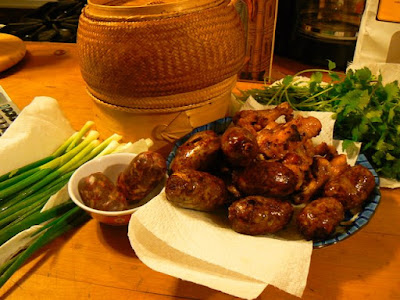
Center right you can see the classic long crystaline structure of MSG
Links
MSG
IFIC dot org
In the early 1900s a Japanese scientist was studying which parts of the tongue recognise different tastes. When testing his wife’s soup flavoured with seaweed, he identified a fifth basic taste. He called it uami, we would call it savoury. It’s what gives that extra good flavour to cooked tomatoes and aged cheeses. The other tastes are sweet, sour, salty, and bitter. Although MSG had been used for thousands of years. that Japanese scientist was the first to isolate the chemical compound that gave us that taste.
MSG doesn’t enhance the taste of all foods, only in those predisposed to a hearty taste. It is used much the way salt or sugar is. If you’ve ever baked a cake you know that the recipe often calls for a quarter teaspoon of salt, similarly homemade cookies. One wouldn’t want cookies or cake to taste salty, but a good cook knows that just that little bit brings out the flavour. Like salt MSG only takes a little bit. If you add salt to a soup until you taste it you’ve already added too much.
Sometimes I’ve heard good cooks who should know better claim that good food doesn’t require MSG. Well I guess not, neither does it require salt or fresh squeezed lime but it might well taste better if it had all three. I’ve never used it on fruit or ice cream but I have in salads containing meat or fish sauce. I use it to marinate meat, in soup stock, in laap, and in jeao, I even use it in those steamed vegetables with sesame called soup pak. I never add it to the foe I buy at a restaurant, I figure it’s already there in the correct proportions.
I first became aware that the MSG myth is simply that when reading an entry into one of the guide books to Thailand penned by the prolific Joe Cummings. I’ll just kind of lift parts from one of the old books.
“Many visitors try to avoid this natural substance, believing they are allergic to it, or that it’s dangerously high in sodium.
For the record, MSG is a simple compound of glutamate, water, and sodium (about two thirds less by weight than in table salt.). Glutamate, an amino acid that occurs naturally in virtually every food, is a major component of most natural protein sources. Like salt and sugar, MSG has been used in Asia for centuries, originally as a distillate of seaweed. Today it’s produced through a natural fermentation and evaporation process using molasses made from sugar cane or sugar beets. …..
Contrary to popular myth, the human body metabolises glutamate added to food the same way it metabolises glutamate already found in food. Although some people report physical reactions to MSG (the so-called Chinese restaurant syndrome) every placebo controlled food research study on humans thus far published has concluded that such reactions can almost always be traced not to MSG but rather to psychological syndromes or to food allergies other than MSG.”

Bang Nuah for sale at the Tesco Nong Khai
In the mid 1990s the American Food and Drug Administration published a politically influenced qualification to their finding that there were no safety issues linked to use of MSG in food. They went on to list symptoms which “may occur” even though they could find no instance of them and then went on to list all the anecdotal evidence. Kind of similar to the right wing’s attempts to deny global warming.
In my minds eye I can just imagine Bill woofing down huge take away dinners of Chinese food and Hillary looking on concerned and noticing the flushing and sweating from his clogged arteries and attributing it to an MSG attack. Rapid fluttering heartbeats, shortness of breath, dreaming of Monica.
If I had to identify a typical sufferer of MSG I’d say a female with a college degree in something not scientific, whose parents were in the upper fifth by income in the United States. Certainly not the 2 billion (billion with a B) Asians who have used it daily without any reaction their entire lives.
Scientifically there is little interest in more studies of MSG. There’s nothing there. Friends who are chemists find it laughable. All a scientist has to do is review studies already done and the conclusions are obvious. Yet the urban legend continues.
I attribute the belief to the same source that creates the beliefs in aroma therapy or grand conspiracies. Deep down I think we all need to find reasons for things we don’t understand. The older I get the more commonality I find between the Akha who live in a village where there is not one literate person who has ever attended a school, and our supposed sophisticated educated modern society.















